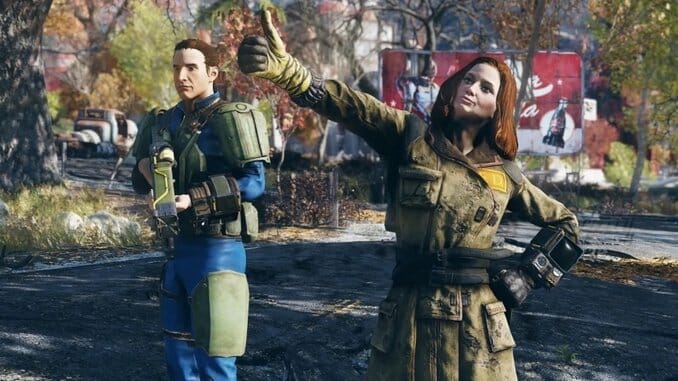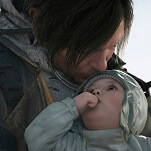How Fallout 76 Players Use Emotes to Build a Welcoming Community

The players of Fallout 76 are not as antisocial as Bethesda thought they would be. Whether they’re roleplaying as a wasteland doctor, fundraising for a community member in need, or just generally fostering a welcoming environment for new players, the audience has proven that many times. While the game’s MMO format is susceptible to bad player behavior, an active rejection of that culture has played a significant role in the fanbase.
But how has that community developed, despite the opportunity for mischief baked into the game’s design? Part of it has occurred outside of the game itself. From the moment the bounty system was first announced at Quakecon 2018, through online venues like Reddit and social media, there seemed to be a determined set of players who decided to make Fallout 76 a welcoming and friendly space. Griefers do exist, especially on console platforms. But for the most part, the majority shun the antagonistic aspects of the game’s design. This rejection has required ignoring features that directly benefit the player (like Workshops, which prompt PvP encounters), demonstrating their willingness to forego a personal reward to maintain the cooperative atmosphere.
Aiding that social harmony, however, is the game’s communication toolset. Microphone and headset use is opt-in, and text chatting does not exist. Many players rely almost solely on the game’s emote system, which uses tiny illustrations, selected from a menu wheel, as a stand-in for certain thoughts or ideas. Like emojis, the pictures are self-explanatory and reflect commonly recurring situations that require clarification in a virtual setting. For example, a Heart or Thumbs Up is positive, a Thumbs Down is negative. A Question Mark indicates confusion. Follow Me helps coordinate objectives during group activities like Daily Ops, while I’m Sorry is for failing an Event objective.

Whatever the purpose, ultimately, the goal is an improved experience based on improved (and, significantly, less direct) communication. The emotes are open to interpretation, but generally, they help players navigate the nuances and social faux pas of a shared virtual space. Over time, Bethesda has even added more emotes in response to community demand, many of them representing neutral or positive intent. While the selection has been hit or miss, the less relevant emotes are subject to additional reinterpretation in hopes of making them useful. The resulting use supports a surprisingly broad range of expressions. For example, Let’s Cook, an emote intended to facilitate restorative team cooking sessions, is seen at the end of a Fasnacht Event to celebrate the ceremonial bonfire. Finger Guns (categorized as a Taunt) and Flyboy are a way of saying kudos or greeting teammates at the beginning of a Daily Op. Mind Blown is reserved for impressive CAMP designs. While negative encounters still occur in open multiplayer, most players seem to subvert the emotes for either positive or creative purposes.
The subversion of emotes in MMOs is discussed more in detail in the paper “Why Do Players Misuse Emotes in Hearthstone? Negotiating the Use of Communicative Affordances in an Online Multiplayer Game” by Jonne Arjoranta and Marko Siitonen. In it, the researchers observe how different game communities communicate based on the restrictions placed on expressions of complex speech, using Hearthstone as their primary example. They found that even a simple emote can have multiple interpretations, despite the developer’s attempt to limit negative interactions by offering mostly neutral or positive expressions. In a virtual space that lacks the context of voice inflection and body language, anything from timing to mouse movement can signify intent. Where emotes are insufficient, players will take cues from other gameplay aspects to imbue interactions with additional meaning. Ultimately, “the study shows that Hearthstone’s designers’ intent of removing negative experiences is difficult, if not impossible, to realize for two prime reasons. First, players will always try to interpret their opponent’s actions regardless of how restricted are the communicative affordances. Secondly, the game designers are unable to fully eradicate those chance moments during play when misbehavior is possible.”
This broad opportunity for misinterpretation and bad behavior makes ambiguity, such as that that can arise from pictographs, a design risk. And yet, players don’t always subvert communicative affordances solely for griefing. While the study notes that these subversions are often used antisocially in Hearthstone, in Fallout 76, the expanded emote options are subject to endless creativity and convey surprising nuance even when not expressly repurposed. For example, a Wave is often not a simple greeting to a friend or teammate, but a disarming way to announce your presence at a CAMP, so you don’t creep out another player. A Heart is considered more emphatic than a Thumbs Up, and thus, reserved for receiving a gift or admiring a CAMP design. As an apologetic emote, I’m Sorry can be used in many situations but often pops up when a lower level character fails to pull their weight in an Event.






































